THz Surface Plasmons in Wide and Freestanding Graphene Nanoribbon Arrays
Abstract
:1. Introduction
2. Theoretical Framework
2.1. Estimation of Fermi Velocity
- Cut-off energy of 680 eV,
- Out-of-plane distance of 15 ,
- C-C bond lengths of 1.42 ,
- The lattice constant of 2.46 ,
- Dense Monkhorst–Pack grid of ,
- 8 bands: 4 valence bands and 4 conduction bands.
2.2. Semi-Analytical Framework
3. Results and Discussions
3.1. Bandgap, Band Structure, and Density of States
- (i)
- (ii)
- Several one-dimensional (1D) sub-bands appear in the same energy scale ( meV) as the ribbon width increases, giving rise to strong peaks in the DOS,
- (iii)
- All GNRs seem to be semiconducting materials with the first conduction and last valence bands having a quadratic dispersion around the point.
3.2. Plasmonic Properties: Ribbon Width
3.3. Plasmonic Properties: Excitation Angle
3.4. Plasmonic Properties: Electron Relaxation Rate
3.5. Plasmonic Properties: Charge Carrier Density
4. Applications in Molecular Sensing of Aqueous Molecules
5. Conclusions
- The GNR systems considered show bandgap values of a few meV ( meV for nm, meV for nm, meV for nm, and meV for nm).
- The bandgap values decrease as the ribbon widths increase, with a trend that follows an exponentially decreasing behavior.
- The increase in the ribbon width raises the plasmon frequency up to about 20 THz for nm and up to about 40 THz for nm.
- The combination of the ribbon width plus the electro-relaxation rate seems to be the most critical aspect affecting the plasmonic properties because the plasmon frequency is noticeably reduced and shifted to higher values of .
- Forbidden plasmon regions can be observed by changing the electron relaxation rate and plasmon excitation angle.
- The study is restricted to this frequency regime because the water generates strong THz absorption at 1 THz, which severely obscures the response of molecules.
- Two-dimensional GNR arrays of 155 nm wide seem to be interesting platforms to solve this issue because these systems show resonance peaks in the same water frequency absorption region.
- Then, any biological molecule could be directly detected in water without altering the sample via drying processes.
Supplementary Materials
Author Contributions
Funding
Institutional Review Board Statement
Informed Consent Statement
Data Availability Statement
Acknowledgments
Conflicts of Interest
References
- Economou, E.N. Surface Plasmons in Thin Films. Phys. Rev. 1969, 182, 539. [Google Scholar] [CrossRef]
- Altug, H.; Oh, S.-H.; Maier, S.A.; Homola, J. Advances and Applications of Nanophotonic Biosensors. Nat. Nanotechnol. 2022, 17, 5–16. [Google Scholar] [CrossRef]
- Tene, T.; Guevara, M.; Svozilík, J.; Coello-Fiallos, D.; Briceño, J.; Vacacela Gomez, C. Proving Surface Plasmons in Graphene Nanoribbons Organized as 2D Periodic Arrays and Potential Applications in Biosensors. Chemosensors 2022, 10, 514. [Google Scholar] [CrossRef]
- Abir, T.; Tal, M.; Ellenbogen, T. Second-Harmonic Enhancement from a Nonlinear Plasmonic Metasurface Coupled to an Optical Waveguide. Nano Lett. 2022, 22, 2712–2717. [Google Scholar] [CrossRef] [PubMed]
- Ali, A.; El-Mellouhi, F.; Mitra, A.; Aissa, B. Research Progress of Plasmonic Nanostructure-Enhanced Photovoltaic Solar Cells. Nanomaterials 2022, 12, 788. [Google Scholar] [CrossRef] [PubMed]
- Wang, Y.; Chen, K.; Lin, Y.-S.; Yang, B.-R. Plasmonic Metasurface with Quadrilateral Truncated Cones for Visible Perfect Absorber. Phys. E Low-Dimens. Syst. Nanostruct. 2022, 139, 115140. [Google Scholar] [CrossRef]
- Sayed, M.; Yu, J.; Liu, G.; Jaroniec, M. Non-Noble Plasmonic Metal-Based Photocatalysts. Chem. Rev. 2022, 122, 10484–10537. [Google Scholar] [CrossRef]
- Low, T.; Avouris, P. Graphene Plasmonics for Terahertz to Mid-Infrared Applications. ACS Nano 2014, 8, 1086–1101. [Google Scholar] [CrossRef] [Green Version]
- Chen, J.; Badioli, M.; Alonso-González, P.; Thongrattanasiri, S.; Huth, F.; Osmond, J.; Spasenović, M.; Centeno, A.; Pesquera, A.; Godignon, P.; et al. Optical Nano-Imaging of Gate-Tunable Graphene Plasmons. Nature 2012, 487, 77–81. [Google Scholar] [CrossRef] [Green Version]
- Gomez, C.V.; Pisarra, M.; Gravina, M.; Sindona, A. Tunable Plasmons in Regular Planar Arrays of Graphene Nanoribbons with Armchair and Zigzag-Shaped Edges. Beilstein J. Nanotechnol. 2017, 8, 172–182. [Google Scholar] [CrossRef]
- Coello-Fiallos, D.; Tene, T.; Guayllas, J.L.; Haro, D.; Haro, A.; Gomez, C.V. DFT Comparison of Structural and Electronic Properties of Graphene and Germanene: Monolayer and Bilayer Systems. Mater. Today Proc. 2017, 4, 6835–6841. [Google Scholar] [CrossRef]
- Avouris, P.; Dimitrakopoulos, C. Graphene: Synthesis and Applications. Mater. Today 2012, 15, 86–97. [Google Scholar] [CrossRef]
- Villamagua, L.; Carini, M.; Stashans, A.; Gomez, C.V. Band Gap Engineering of Graphene through Quantum Confinement and Edge Distortions. Ric. Mat. 2016, 65, 579–584. [Google Scholar] [CrossRef]
- Dutta, S.; Pati, S.K. Novel Properties of Graphene Nanoribbons: A Review. J. Mater. Chem. 2010, 20, 8207–8223. [Google Scholar] [CrossRef]
- Wang, J.; Zhao, R.; Yang, M.; Liu, Z.; Liu, Z. Inverse Relationship between Carrier Mobility and Bandgap in Graphene. J. Chem. Phys. 2013, 138, 84701. [Google Scholar] [CrossRef] [PubMed] [Green Version]
- Kang, J.W.; Lee, J.H.; Hwang, H.J.; Kim, K.-S. Developing Accelerometer Based on Graphene Nanoribbon Resonators. Phys. Lett. A 2012, 376, 3248–3255. [Google Scholar] [CrossRef]
- Wang, X.; Ouyang, Y.; Li, X.; Wang, H.; Guo, J.; Dai, H. Room-Temperature All-Semiconducting Sub-10-Nm Graphene Nanoribbon Field-Effect Transistors. Phys. Rev. Lett. 2008, 100, 206803. [Google Scholar] [CrossRef] [PubMed] [Green Version]
- Karimi, F.; Knezevic, I. Plasmons in Graphene Nanoribbons. Phys. Rev. B 2017, 96, 125417. [Google Scholar] [CrossRef] [Green Version]
- Aguillon, F.; Marinica, D.C.; Borisov, A.G. Atomic-Scale Control of Plasmon Modes in Graphene Nanoribbons. Phys. Rev. B 2022, 105, L081401. [Google Scholar] [CrossRef]
- Gomez, C.V.; Pisarra, M.; Gravina, M.; Pitarke, J.M.; Sindona, A. Plasmon Modes of Graphene Nanoribbons with Periodic Planar Arrangements. Phys. Rev. Lett. 2016, 117, 116801. [Google Scholar]
- Fei, Z.; Goldflam, M.D.; Wu, J.-S.; Dai, S.; Wagner, M.; McLeod, A.S.; Liu, M.K.; Post, K.W.; Zhu, S.; Janssen, G.; et al. Edge and Surface Plasmons in Graphene Nanoribbons. Nano Lett. 2015, 15, 8271–8276. [Google Scholar] [CrossRef] [PubMed]
- Sindona, A.; Pisarra, M.; Bellucci, S.; Tene, T.; Guevara, M.; Gomez, C.V. Plasmon Oscillations in Two-Dimensional Arrays of Ultranarrow Graphene Nanoribbons. Phys. Rev. B 2019, 100, 235422. [Google Scholar] [CrossRef]
- Sindona, A.; Vacacela Gomez, C.; Pisarra, M. Dielectric Screening versus Geometry Deformation in Two-Dimensional Allotropes of Silicon and Germanium. Sci. Rep. 2022, 12, 1–12. [Google Scholar] [CrossRef] [PubMed]
- Gomez, C.V.; Pisarra, M.; Gravina, M.; Riccardi, P.; Sindona, A. Plasmon Properties and Hybridization Effects in Silicene. Phys. Rev. B 2017, 95, 85419. [Google Scholar]
- Tene, T.; Guevara, M.; Viteri, E.; Maldonado, A.; Pisarra, M.; Sindona, A.; Vacacela Gomez, C.; Bellucci, S. Calibration of Fermi Velocity to Explore the Plasmonic Character of Graphene Nanoribbon Arrays by a Semi-Analytical Model. Nanomaterials 2022, 12, 2028. [Google Scholar] [CrossRef] [PubMed]
- Lin, M.-W.; Ling, C.; Zhang, Y.; Yoon, H.J.; Cheng, M.M.-C.; Agapito, L.A.; Kioussis, N.; Widjaja, N.; Zhou, Z. Room-Temperature High on/off Ratio in Suspended Graphene Nanoribbon Field-Effect Transistors. Nanotechnology 2011, 22, 265201. [Google Scholar] [CrossRef] [Green Version]
- Hu, H.; Yu, R.; Teng, H.; Hu, D.; Chen, N.; Qu, Y.; Yang, X.; Chen, X.; McLeod, A.S.; Alonso-González, P.; et al. Active Control of Micrometer Plasmon Propagation in Suspended Graphene. Nat. Commun. 2022, 13, 1–9. [Google Scholar] [CrossRef]
- Popov, V.V.; Bagaeva, T.Y.; Otsuji, T.; Ryzhii, V. Oblique Terahertz Plasmons in Graphene Nanoribbon Arrays. Phys. Rev. B 2010, 81, 73404. [Google Scholar] [CrossRef]
- Gomez, C.V.; Guevara, M.; Tene, T.; Lechon, L.S.; Merino, B.; Brito, H.; Bellucci, S. Energy Gap in Graphene and Silicene Nanoribbons: A Semiclassical Approach. In Proceedings of the 2nd International Congress on Physics ESPOCH (ICPE-2017), Riobamba, Ecuador, 6–8 December 2017; Volume 2003, p. 20015. [Google Scholar]
- Gonze, X.; Amadon, B.; Anglade, P.-M.; Beuken, J.-M.; Bottin, F.; Boulanger, P.; Bruneval, F.; Caliste, D.; Caracas, R.; Côté, M.; et al. ABINIT: First-Principles Approach to Material and Nanosystem Properties. Comput. Phys. Commun. 2009, 180, 2582–2615. [Google Scholar] [CrossRef]
- Kohn, W. Density-Functional Theory for Excited States in a Quasi-Local-Density Approximation. Phys. Rev. A 1986, 34, 737. [Google Scholar] [CrossRef]
- Hwang, C.; Siegel, D.A.; Mo, S.-K.; Regan, W.; Ismach, A.; Zhang, Y.; Zettl, A.; Lanzara, A. Fermi Velocity Engineering in Graphene by Substrate Modification. Sci. Rep. 2012, 2, 590. [Google Scholar] [CrossRef] [Green Version]
- Sindona, A.; Pisarra, M.; Gomez, C.V.; Riccardi, P.; Falcone, G.; Bellucci, S. Calibration of the Fine-Structure Constant of Graphene by Time-Dependent Density-Functional Theory. Phys. Rev. B 2017, 96, 201408. [Google Scholar] [CrossRef]
- Barone, V.; Hod, O.; Scuseria, G.E. Electronic Structure and Stability of Semiconducting Graphene Nanoribbons. Nano Lett. 2006, 6, 2748–2754. [Google Scholar] [CrossRef] [PubMed]
- Han, M.Y.; Özyilmaz, B.; Zhang, Y.; Kim, P. Energy Band-Gap Engineering of Graphene Nanoribbons. Phys. Rev. Lett. 2007, 98, 206805. [Google Scholar] [CrossRef] [Green Version]
- Yang, L.; Park, C.-H.; Son, Y.-W.; Cohen, M.L.; Louie, S.G. Quasiparticle Energies and Band Gaps in Graphene Nanoribbons. Phys. Rev. Lett. 2007, 99, 186801. [Google Scholar] [CrossRef]
- Pisarra, M.; Sindona, A.; Riccardi, P.; Silkin, V.M.; Pitarke, J.M. Acoustic Plasmons in Extrinsic Free-Standing Graphene. New J. Phys. 2014, 16, 83003. [Google Scholar] [CrossRef] [Green Version]
- Gomez, C.V.; Pisarra, M.; Gravina, M.; Bellucci, S.; Sindona, A. Ab Initio Modelling of Dielectric Screening and Plasmon Resonances in Extrinsic Silicene. In Proceedings of the 2016 IEEE 2nd International Forum on Research and Technologies for Society and Industry Leveraging a Better Tomorrow (RTSI), Bologna, Italy, 7–9 September 2016; pp. 1–4. [Google Scholar]
- de Abajo, F.J. Graphene Plasmonics: Challenges and Opportunities. Acs Photonics 2014, 1, 135–152. [Google Scholar] [CrossRef] [Green Version]
- Whelan, P.R.; Shen, Q.; Zhou, B.; Serrano, I.G.; Kamalakar, M.V.; Mackenzie, D.M.A.; Ji, J.; Huang, D.; Shi, H.; Luo, D.; et al. Fermi Velocity Renormalization in Graphene Probed by Terahertz Time-Domain Spectroscopy. 2D Mater. 2020, 7, 35009. [Google Scholar] [CrossRef]
- Eckmann, A.; Felten, A.; Mishchenko, A.; Britnell, L.; Krupke, R.; Novoselov, K.S.; Casiraghi, C. Probing the Nature of Defects in Graphene by Raman Spectroscopy. Nano Lett. 2012, 12, 3925–3930. [Google Scholar] [CrossRef] [Green Version]
- Guo, H.; Wang, J. Effect of Vacancy Defects on the Vibration Frequency of Graphene Nanoribbons. Nanomaterials 2022, 12, 764. [Google Scholar] [CrossRef]
- Zhou, J.; Zhao, X.; Huang, G.; Yang, X.; Zhang, Y.; Zhan, X.; Tian, H.; Xiong, Y.; Wang, Y.; Fu, W. Molecule-Specific Terahertz Biosensors Based on an Aptamer Hydrogel-Functionalized Metamaterial for Sensitive Assays in Aqueous Environments. ACS Sens. 2021, 6, 1884–1890. [Google Scholar] [CrossRef] [PubMed]
- Wu, L.; Chu, H.-S.; Koh, W.S.; Li, E.-P. Highly Sensitive Graphene Biosensors Based on Surface Plasmon Resonance. Opt. Express 2010, 18, 14395–14400. [Google Scholar] [CrossRef] [PubMed]
- Fu, H.; Zhang, S.; Chen, H.; Weng, J. Graphene Enhances the Sensitivity of Fiber-Optic Surface Plasmon Resonance Biosensor. IEEE Sens. J. 2015, 15, 5478–5482. [Google Scholar] [CrossRef]
- Sadeghi, Z.; Shirkani, H. Highly Sensitive Mid-Infrared SPR Biosensor for a Wide Range of Biomolecules and Biological Cells Based on Graphene-Gold Grating. Phys. E Low-Dimens. Syst. Nanostruct. 2020, 119, 114005. [Google Scholar] [CrossRef]
- Zhang, H.; Song, D.; Gao, S.; Zhang, J.; Zhang, H.; Sun, Y. Novel SPR Biosensors Based on Metal Nanoparticles Decorated with Graphene for Immunoassay. Sens. Actuators B Chem. 2013, 188, 548–554. [Google Scholar] [CrossRef]
- Mulpur, P.; Podila, R.; Lingam, K.; Vemula, S.K.; Ramamurthy, S.S.; Kamisetti, V.; Rao, A.M. Amplification of Surface Plasmon Coupled Emission from Graphene-Ag Hybrid Films. J. Phys. Chem. C 2013, 117, 17205–17210. [Google Scholar] [CrossRef]
- Ling, X.; Xie, L.; Fang, Y.; Xu, H.; Zhang, H.; Kong, J.; Dresselhaus, M.S.; Zhang, J.; Liu, Z. Can Graphene Be Used as a Substrate for Raman Enhancement? Nano Lett. 2010, 10, 553–561. [Google Scholar] [CrossRef]
- Jornet, J.M.; Ian, F.A. Graphene-based plasmonic nano-transceiver for terahertz band communication. In Proceedings of the 8th European Conference on Antennas and Propagation (EuCAP 2014), The Hague, The Netherlands, 6–11 April 2014; IEEE: New York, NY, USA, 2014. [Google Scholar]
- Naghdehforushha, S.A.; Gholamreza, M. High directivity plasmonic graphene-based patch array antennas with tunable THz band communications. Optik 2018, 168, 440–445. [Google Scholar] [CrossRef]
- Pisarra, M.; Gomez, C.V.; Sindona, A. Massive and massless plasmons in germanene nanosheets. Sci. Rep. 2022, 12, 1–15. [Google Scholar] [CrossRef]
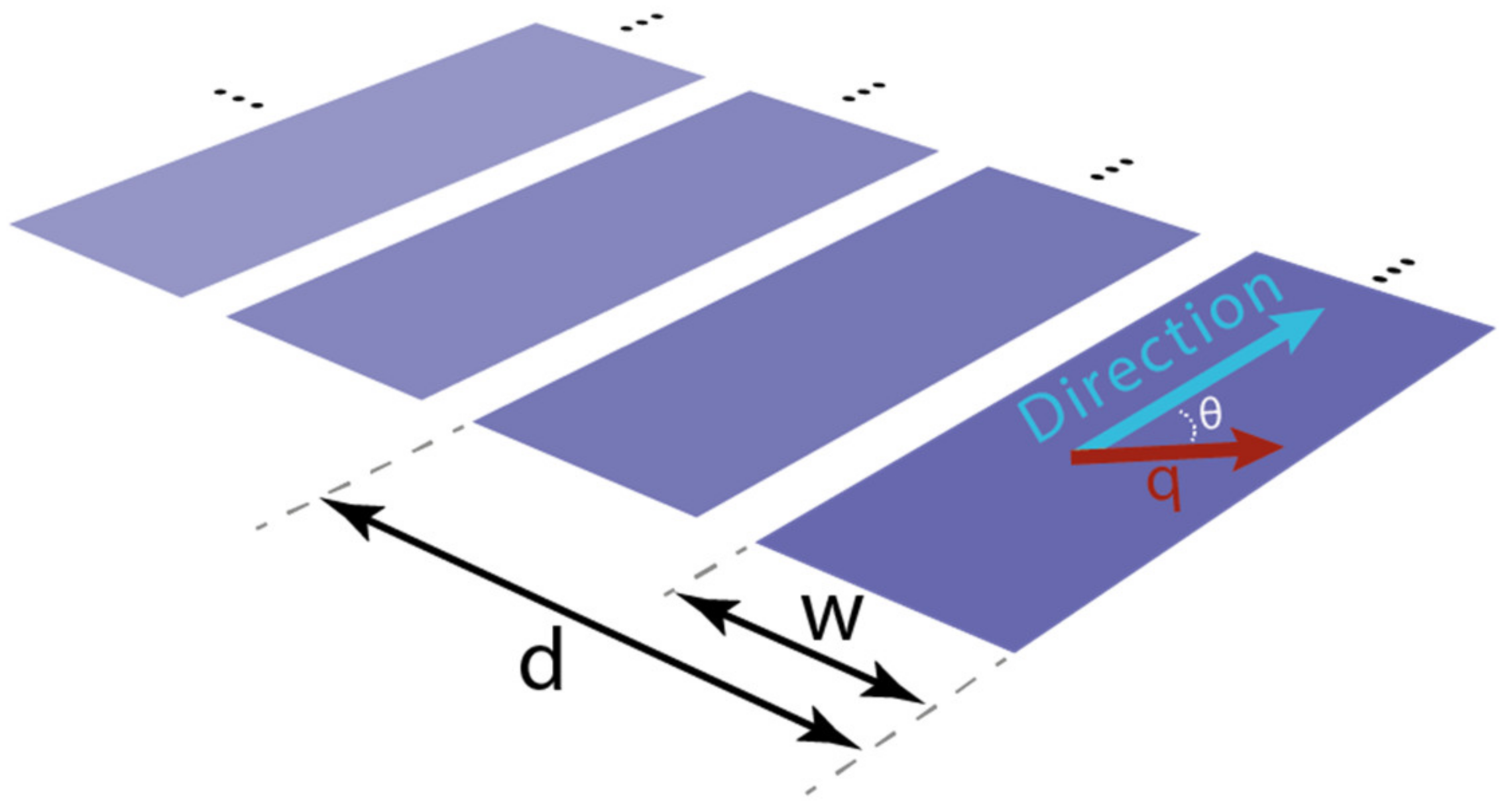

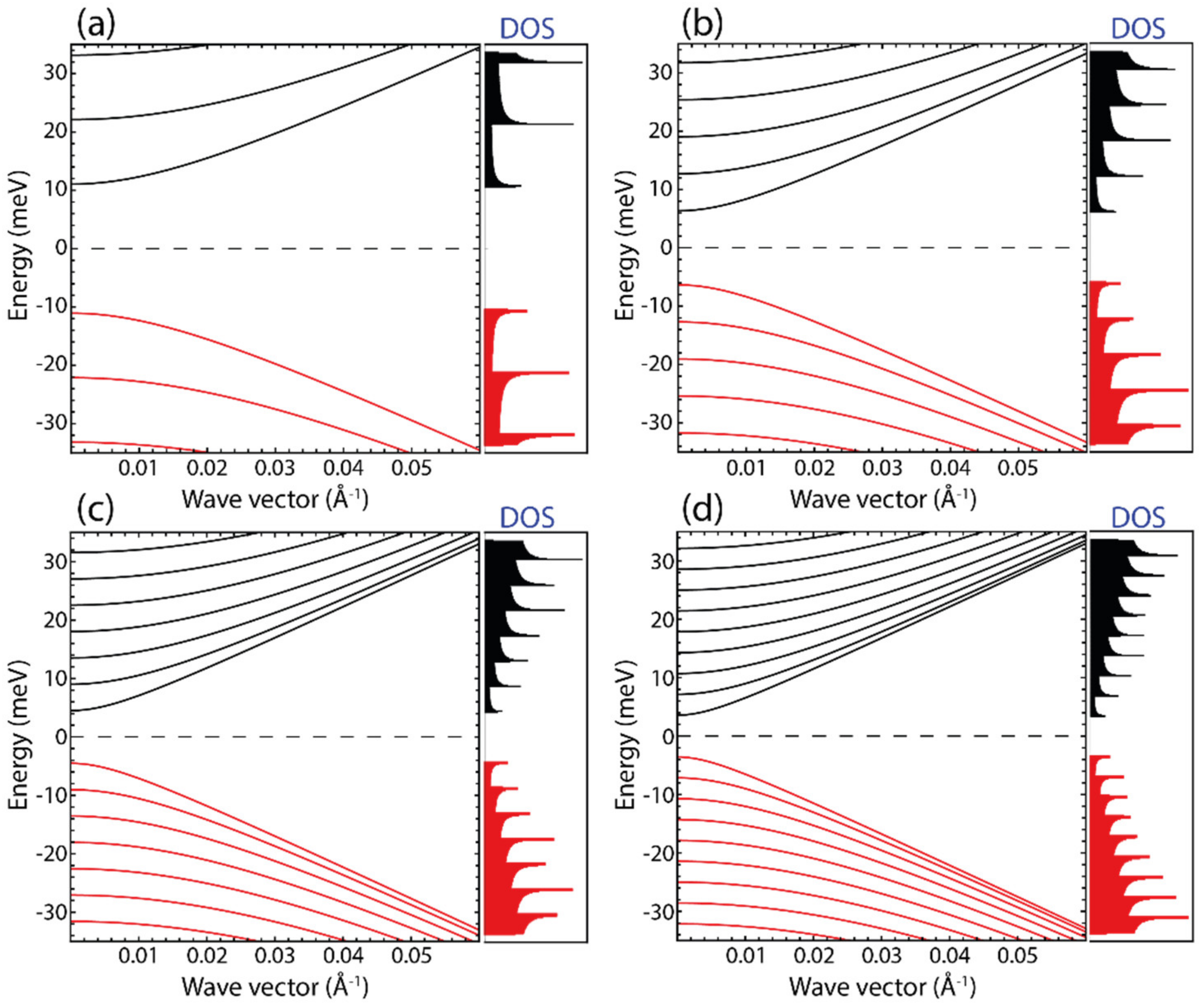
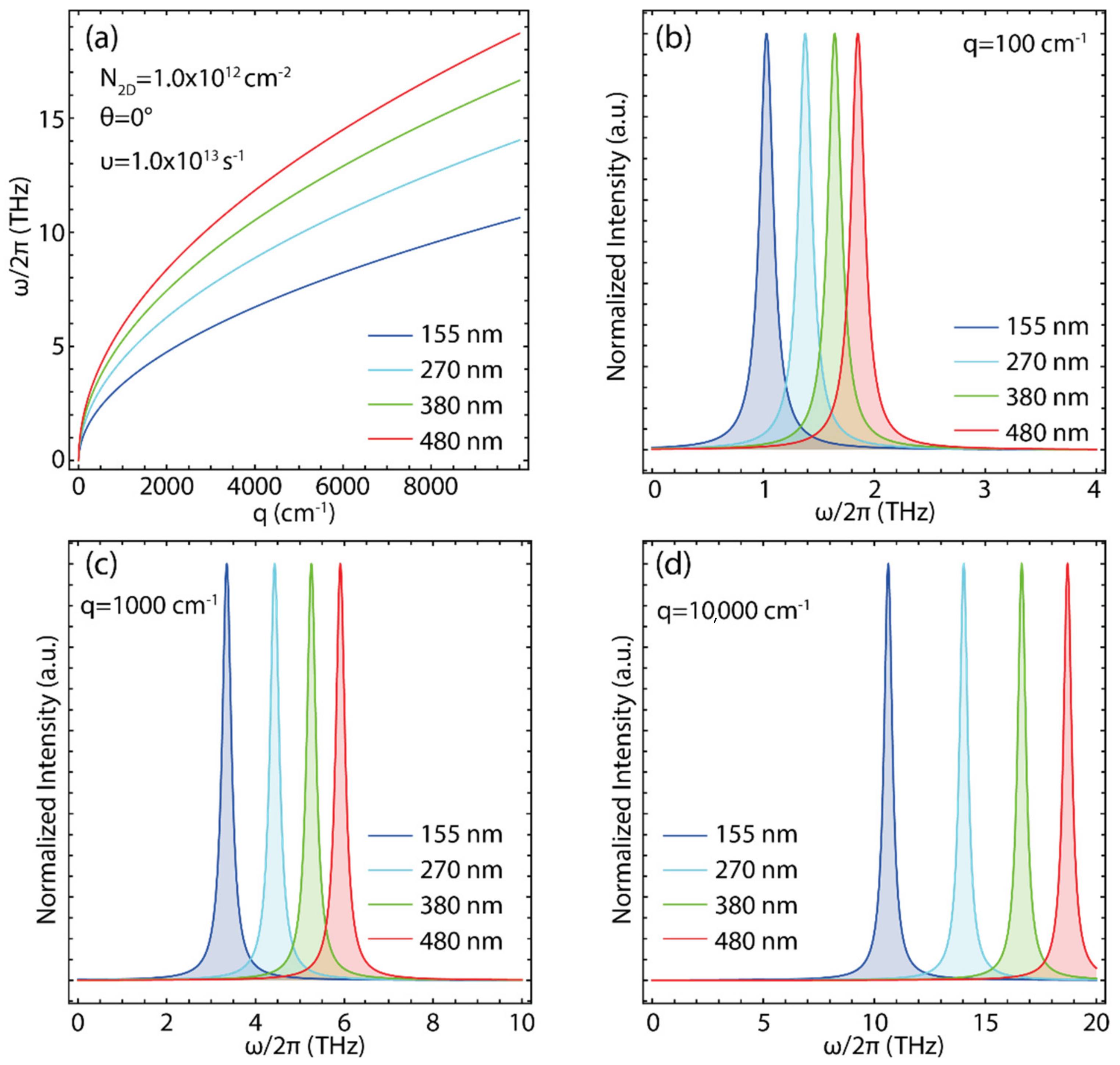


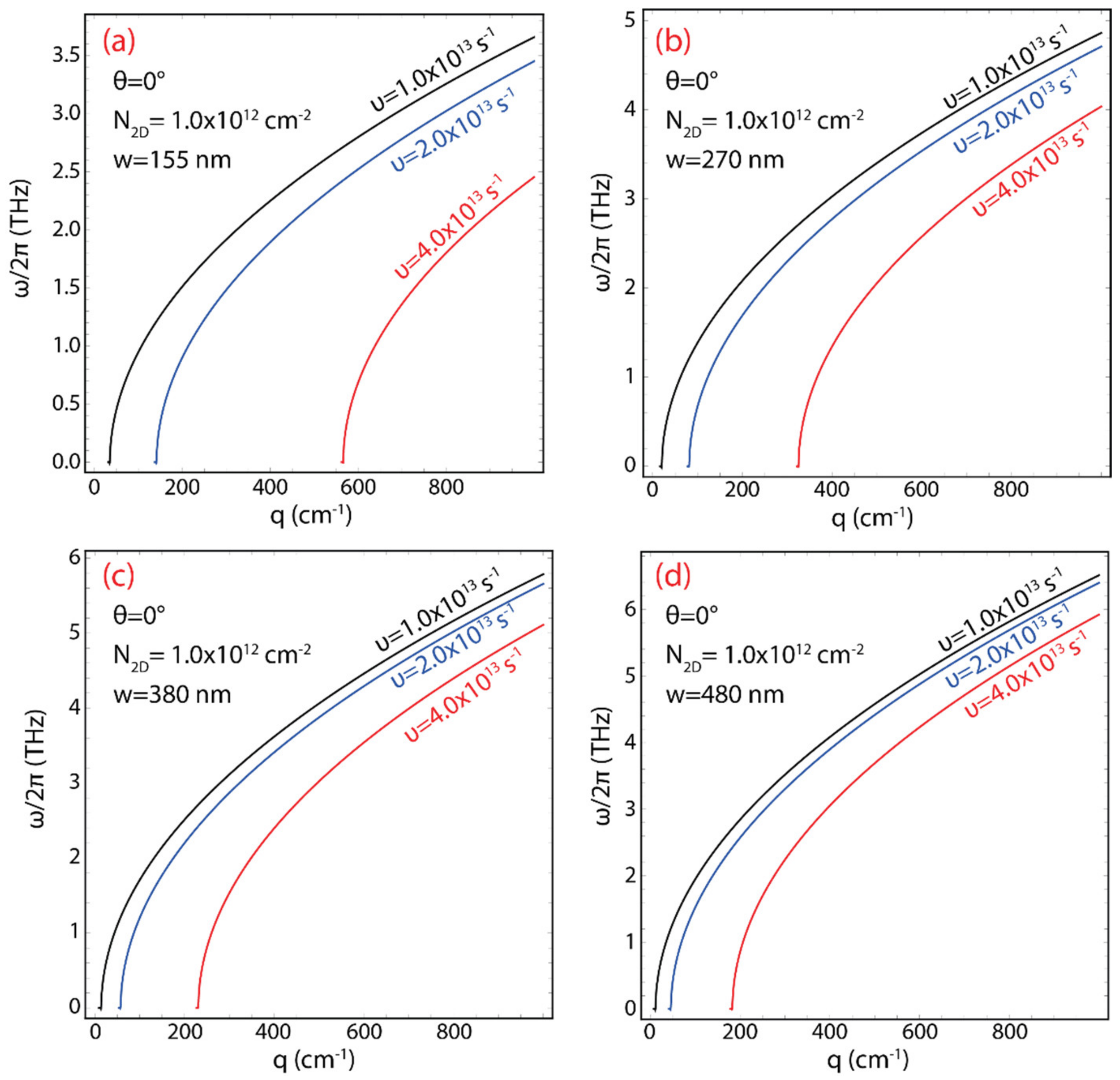
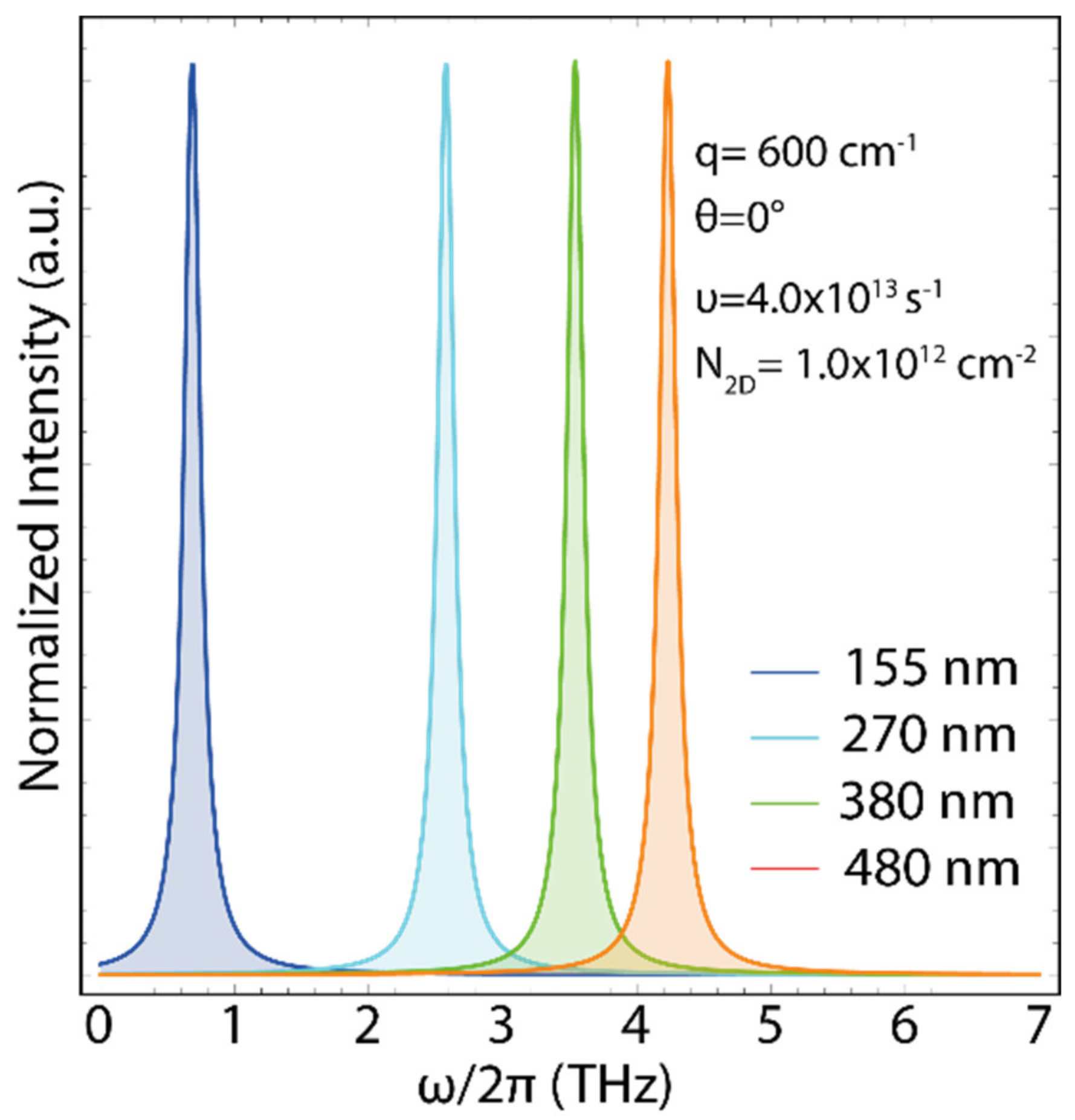


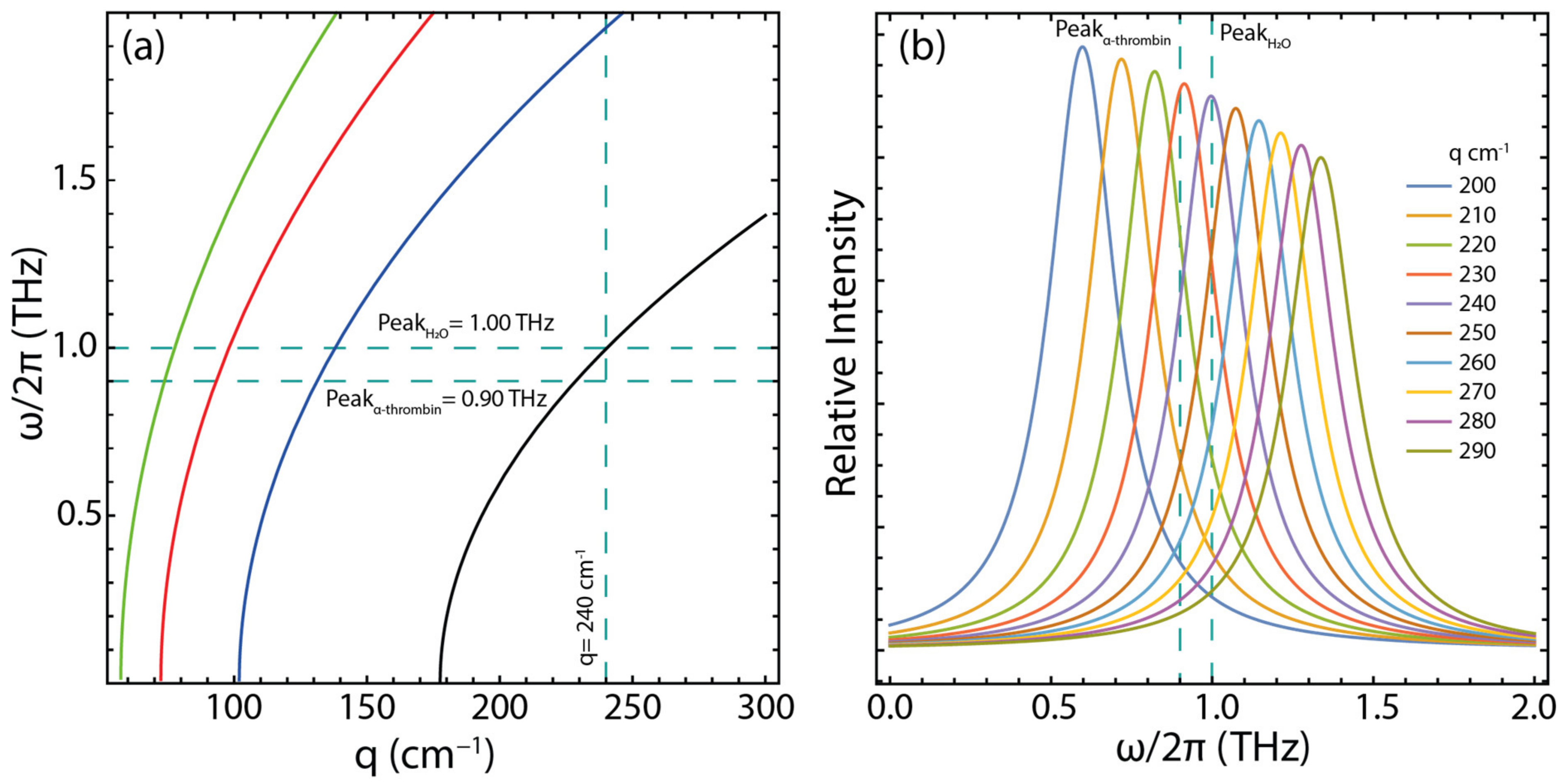
| Ribbon Width (nm) | Bandgap (meV) | |
|---|---|---|
| 155 | 22.12 | |
| 270 | 12.70 | |
| 380 | 9.02 | |
| 480 | 7.14 |
| Ribbon Width (nm) | |||
|---|---|---|---|
| 155 | 1.03 | 3.35 | 10.63 |
| 270 | 1.38 | 4.43 | 14.03 |
| 380 | 1.64 | 5.26 | 16.65 |
| 480 | 1.85 | 5.91 | 18.71 |
| Ribbon Width (nm) | |||
|---|---|---|---|
| 25.36 | 24.38 | 26.16 | |
| 15.85 | 15.78 | 15.74 | |
| 11.35 | 11.00 | 11.01 |
| - | 0.87 | 1.31 | 1.60 | |
| 1.05 | 1.75 | 2.23 | 2.59 | |
| 1.56 | 2.32 | 2.87 | 3.29 | |
| 1.94 | 2.78 | 3.39 | 3.86 | |
| 2.26 | 3.17 | 3.84 | 4.37 | |
| 2.54 | 3.52 | 4.25 | 4.81 | |
| 2.79 | 3.83 | 4.61 | 5.23 | |
| 3.02 | 4.12 | 4.96 | 5.61 | |
| 3.23 | 4.40 | 5.27 | 5.96 | |
| 3.43 | 4.65 | 5.58 | 6.30 |
| Ribbon Width (nm) | |||
|---|---|---|---|
| 39.85 | 28.71 | 26.24 | |
| 21.52 | 17.45 | 16.67 | |
| 13.90 | 12.13 | 11.43 |
| - | - | - | - | |
| - | - | - | 0.86 | |
| - | - | 1.53 | 2.24 | |
| - | 1.35 | 2.40 | 3.05 | |
| - | 2.06 | 3.02 | 3.69 | |
| 0.69 | 2.58 | 3.54 | 4.23 | |
| 1.36 | 3.01 | 3.99 | 4.71 | |
| 1.80 | 3.39 | 4.40 | 5.15 | |
| 2.15 | 3.72 | 4.77 | 5.55 | |
| 2.45 | 4.04 | 5.11 | 5.92 |
| Ribbon Width (nm) | |||
|---|---|---|---|
| 73.26 | 46.90 | 39.36 | |
| 27.12 | 22.95 | 20.94 | |
| 16.31 | 14.56 | 13.68 |
| 6.72 | 8.87 | 10.53 | 11.83 | |
| 9.51 | 12.55 | 14.89 | 16.73 | |
| 11.65 | 15.37 | 18.24 | 20.50 | |
| 13.45 | 17.75 | 21.05 | 23.67 | |
| 15.04 | 19.84 | 23.54 | 26.46 | |
| 16.47 | 21.74 | 25.79 | 28.99 | |
| 17.79 | 23.48 | 27.86 | 31.31 | |
| 19.02 | 25.10 | 29.78 | 33.47 | |
| 20.17 | 26.62 | 31.59 | 35.50 | |
| 21.26 | 28.06 | 33.29 | 37.42 |
| Ribbon Width (nm) | |||
|---|---|---|---|
| 24.24 | 24.19 | 24.23 | |
| 15.76 | 15.72 | 15.71 | |
| 10.99 | 11.04 | 11.04 |
Disclaimer/Publisher’s Note: The statements, opinions and data contained in all publications are solely those of the individual author(s) and contributor(s) and not of MDPI and/or the editor(s). MDPI and/or the editor(s) disclaim responsibility for any injury to people or property resulting from any ideas, methods, instructions or products referred to in the content. |
© 2022 by the authors. Licensee MDPI, Basel, Switzerland. This article is an open access article distributed under the terms and conditions of the Creative Commons Attribution (CC BY) license (https://creativecommons.org/licenses/by/4.0/).
Share and Cite
Tene, T.; Guevara, M.; Cevallos, Y.; Sáez Paguay, M.Á.; Bellucci, S.; Vacacela Gomez, C. THz Surface Plasmons in Wide and Freestanding Graphene Nanoribbon Arrays. Coatings 2023, 13, 28. https://doi.org/10.3390/coatings13010028
Tene T, Guevara M, Cevallos Y, Sáez Paguay MÁ, Bellucci S, Vacacela Gomez C. THz Surface Plasmons in Wide and Freestanding Graphene Nanoribbon Arrays. Coatings. 2023; 13(1):28. https://doi.org/10.3390/coatings13010028
Chicago/Turabian StyleTene, Talia, Marco Guevara, Yesenia Cevallos, Miguel Ángel Sáez Paguay, Stefano Bellucci, and Cristian Vacacela Gomez. 2023. "THz Surface Plasmons in Wide and Freestanding Graphene Nanoribbon Arrays" Coatings 13, no. 1: 28. https://doi.org/10.3390/coatings13010028










